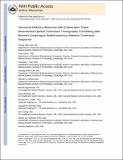Structural markers observed with endoscopic 3-dimensional optical coherence tomography correlating with Barrett's esophagus radiofrequency ablation treatment response
Author(s)
Tsai, Tsung-Han; Zhou, Chao; Tao, Yuankai K.; Lee, Hsiang-Chieh; Figueiredo, Marisa; Kirtane, Tejas; Adler, Desmond C.; Schmitt, Joseph M.; Huang, Qin; Fujimoto, James G.; Mashimo, Hiroshi; Ahsen, Osman Oguz; ... Show more Show less
DownloadFujimoto_Structural markers.pdf (996.7Kb)
PUBLISHER_CC
Publisher with Creative Commons License
Creative Commons Attribution
Terms of use
Metadata
Show full item recordAbstract
Background
Radiofrequency ablation (RFA) is effective for treating Barrett's esophagus (BE) but often involves multiple endoscopy sessions over several months to achieve complete response.
Objective
Identify structural markers that correlate with treatment response by using 3-dimensional (3-D) optical coherence tomography (OCT; 3-D OCT).
Design
Cross-sectional.
Setting
Single teaching hospital.
Patients
Thirty-three patients, 32 male and 1 female, with short-segment (<3 cm) BE undergoing RFA treatment.
Intervention
Patients were treated with focal RFA, and 3-D OCT was performed at the gastroesophageal junction before and immediately after the RFA treatment. Patients were re-examined with standard endoscopy 6 to 8 weeks later and had biopsies to rule out BE if not visibly evident.
Main Outcome Measurements
The thickness of BE epithelium before RFA and the presence of residual gland-like structures immediately after RFA were determined by using 3-D OCT. The presence of BE at follow-up was assessed endoscopically.
Results
BE mucosa was significantly thinner in patients who achieved complete eradication of intestinal metaplasia than in patients who did not achieve complete eradication of intestinal metaplasia at follow-up (257 ± 60 μm vs 403 ± 86 μm; P < .0001). A threshold thickness of 333 μm derived from receiver operating characteristic curves corresponded to a 92.3% sensitivity, 85% specificity, and 87.9% accuracy in predicting the presence of BE at follow-up. The presence of OCT-visible glands immediately after RFA also correlated with the presence of residual BE at follow-up (83.3% sensitivity, 95% specificity, 90.6% accuracy).
Limitations
Single center, cross-sectional study in which only patients with short-segment BE were examined.
Conclusion
Three-dimensional OCT assessment of BE thickness and residual glands during RFA sessions correlated with treatment response. Three-dimensional OCT may predict responses to RFA or aid in making real-time RFA retreatment decisions in the future.
Date issued
2012-12Department
Massachusetts Institute of Technology. Department of Electrical Engineering and Computer Science; Massachusetts Institute of Technology. Research Laboratory of ElectronicsJournal
Gastrointestinal Endoscopy
Publisher
Elsevier
Citation
Tsai, Tsung-Han, Chao Zhou, Yuankai K. Tao, Hsiang-Chieh Lee, Osman O. Ahsen, Marisa Figueiredo, Tejas Kirtane, et al. “Structural Markers Observed with Endoscopic 3-Dimensional Optical Coherence Tomography Correlating with Barrett’s Esophagus Radiofrequency Ablation Treatment Response (with Videos).” Gastrointestinal Endoscopy 76, no. 6 (December 2012): 1104–1112.
Version: Author's final manuscript
ISSN
00165107